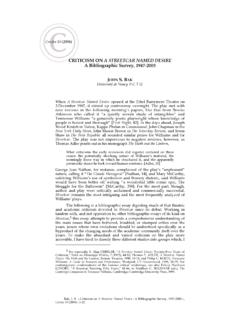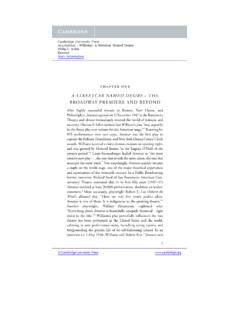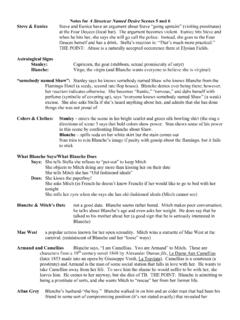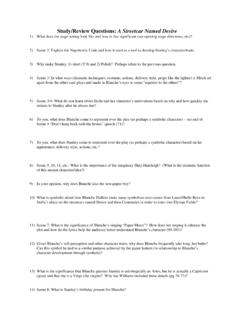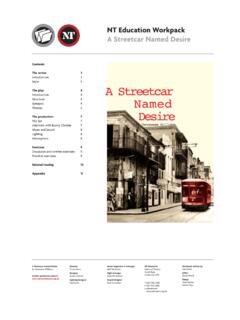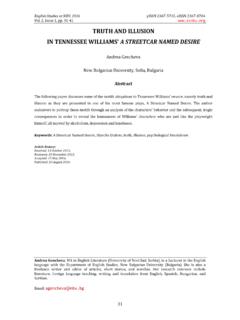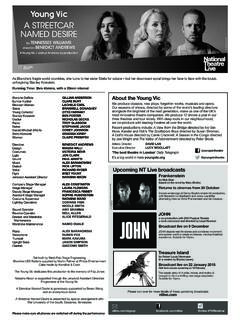Transcription of Teaching Tennessee Williams A Streetcar Named …
1 Teaching Tennessee Williams 'sfrom Multiple Critical PerspectivesEdited byDouglas GrudzinaMultiple Critical Perspectives A Streetcar Named Desire2 Pr e s t w i c k Ho u s e, in Critical PerspectivesA Streetcar Named Desire2 Pr e s t w i c k Ho u s e, in Box 658, Clayton, DE 978-1-935464-26-6 Item No. 305044 Copyright 2009 Prestwick House, Inc. All rights portion may be reproduced without permission in writing from the publisher. 1984 Animal Farm Anthem Antigone Awakening, TheBeowulf Brave New WorldCatcher in the Rye, TheComedy of Errors, The Crucible, The Cry, the Beloved Country Death of a Salesman Doll s House, A Ethan Frome Fahrenhiet 451 Frankenstein Grapes of Wrath, The Great Expectations Great Gatsby, The Hamlet Heart of Darkness House on Mango Street, The I Know Why the Caged Bird SingsImportance of Being Earnest, The Invisible Man (Ellison)
2 Jane Eyre Joy Luck Club, TheJungle, TheKing LearLesson Before Dying, ALife of Pi Lord of the Flies Macbeth MedeaMerchant of Venice, The Metamorphosis, The Midsummer Night s Dream, A Much Ado About Nothing Oedipus Rex Of Mice and Men Old Man and the Sea, TheOur Town Picture of Dorian Gray, The Pride and Prejudice Raisin in the Sun, A Richard III Romeo and Juliet Scarlet Letter, The Separate Peace, A Siddhartha Slaughterhouse-FiveStreetcar Named desire , ATale of Two Cities, A Taming of the Shrew, The Tempest, The Things Fall ApartThings They Carried, TheTo Kill a Mockingbird Transcendentalism Twelfth Night Wuthering Heights Other titles in the Multiple Critical Perspective series include:A convenient order form is located in the back of this book. Pr e s t w i c k Ho u s e, in c. 3 Multiple Critical PerspectivesA Streetcar Named DesireA Message to theTeacher of LiteratureOP e n y o u r s t u d e n t s e y e s a n d m i n d s with this new, ex-citing approach to Teaching this guide, you will find reproducible activities, as well as clear and concise explanations of three contemporary critical perspectives feel free to reproduce as much, or as little, of the material for your students notebooks.
3 You will also find specific suggestions to help you examine this familiar title in new and exciting ways. Your students will seize the opportunity to discuss, present orally, and write about their new you will not find is an answer key. To the femi-nist, the feminist approach is the correct approach, just as the Freudian will hold to the Freudian. Truly, the point of this guide is to examine, question, and consider, not merely arrive at right will also find this to be a versatile guide. Use it in concert with our Teaching Unit or our Advanced Place-ment Teaching Unit. Use it along with our Response Jour-nal, or use it as your entire study of this title. However you choose to use it, we are confident you ll be thrilled with the new life you find in an old title, as well as in your Pr e s t w i c k Ho u s e, in Critical PerspectivesA Streetcar Named DesireGeneral Introduction To The Work.
4 6 Introduction to A Streetcar Named desire ..6 Genre ..7 Plot Summary ..9 Characters ..12 Formalist Approach Applied to A Streetcar Named desire ..13 Notes on the Formalist Approach ..13 Essential Questions for A Formalist Reading ..16 Activity One: Analyzing the Repetitive Use of Musical Themes ..17 Activity Two: Analyzing the Use of Costume to Develop the Character ..24 Activity Three: Analyzing William s Use of Motifs and Recurring Imagery ..30 Discussion Questions ..34 Essays Or Writing Assignments ..34 Table of Contents Pr e s t w i c k Ho u s e, in c. 5 Multiple Critical PerspectivesA Streetcar Named DesireFeminist Theory Applied to A Streetcar Named desire ..35 Notes on the Feminist Theory ..35 Essential Questions for A Feminist Reading ..38 Activity One: Analyzing the Portrayal of Women as Dependent Upon Men ..39 Activity Two: Discerning the Playwright s Attitude Toward Domestic Violence.
5 46 Activity Three: Examining Blanche s Rape as Either Dramatic Device or Misogynistic Statement ..53 Discussion Questions ..59 Essays Or Writing Assignments ..59 Psychoanalytic Theory Applied to A Streetcar Named desire ..61 Notes on the Psychoanalytic Theory ..61 Essential Questions for A Psychoanalytic Reading ..64 Activity One: Discerning the Relationship Between the Playwright and his Protagonist ..66 Activity Two: Exploring the Conflict Between the Id and Superego of Blanche DuBois ..71 Activity Three: Analyzing Stanley, Stella, and Blanche as the Three Aspects of the Personality ..74 Discussion Questions ..78 Essays Or Writing Assignments ..786 Pr e s t w i c k Ho u s e, in Critical PerspectivesA Streetcar Named DesireGeneral Introduction to the WorkIntroduction to A Streetcar Named DesireOP e n i n g o n de c. 3, 1947, A Streetcar Named desire secured Tennessee Williams s place in the pan-theon of American playwrights.
6 With its raw depiction of alcoholism, sexuality including an offstage rape and explosive human emotion, the play shocked and thrilled critics and audiences alike. The drama won for Williams the first of his two Pulitzer Prizes. Set in New Orleans, where Williams lived for a time, A Streetcar Named desire tells the story of the colos-sal and ultimately disastrous culture clash between Blanche DuBois, a fragile aging Southern belle, prone to drink and mendacity, and Stanley Kowalski, her brutally masculine, blue-collar brother-in-law. Stella Kowalski, sister to Blanche and wife to Stanley, forms the third point of this human Bermuda triangle. Elia Kazan, an award-winner producer and director of both films and stage play, and a successful playwright and novelist, directed the Broadway production of A Streetcar Named desire , as well as the 1951 film version.
7 The drama introduced audiences to the raw power of a 23-year-old actor Named Marlon Brando and starred a young Jessica Tandy in the stage production. In later years, Williams confirmed that when he wrote the play, he intended for Blanche to be the more sympathetic character, a relic of the South s past, destroyed by the barbaric Stanley. However, audi-ences thrilled to Brando, whose performance overpowered his costars. According to an Internet Movie Database biography of Brando, Kazan feared the audience was becoming too enamored of Brando and suggested toning down the part, lest the actor s power undermine the audience s sympathy for Blanche. Williams , who also was enthralled with Brando, was not worried and permitted the actor to exercise his full range of power. As with many of Williams s works, A Streetcar Named desire contains overt and subtle autobiographi-cal elements.
8 Williams , who was openly homosexual, struggled for much of his life with alcoholism and depression, much like his protagonist, Blanche. The movie garnered twelve Academy Award nominations and won four Oscars for best actress (Vivian Leigh), best supporting actress (Kim Hunter), best supporting actor (Karl Malden) and best art direction. Ironically, Brando, who remains the actor most identified with Streetcar , and director Kazan, the person most responsible for bringing Williams s work to life, were nominated for Oscars but did not win. Pr e s t w i c k Ho u s e, in c. 7 Multiple Critical PerspectivesA Streetcar Named DesireGenre A Streetcar Named desire is a one-act play with eleven scenes. The work is a tragedy, a serious drama in which the problems and flaws of the central characters lead to an unhappy or catastrophic ending. The original Greek word tragoidia roughly means the song of the goat, from tragos (goat) and oide (ode or song).
9 The structure of the classic dramatic tragedy, as outlined by the Greek philosopher Aristotle, is unified by place, time, and plot. In other words, the story is set in a single location, within a discrete time period, and is built around a series of actions that pertain to a single, central plot. In a classic tragedy, the story is told in a straightforward, chronological fashion, as the rising action builds toward a crisis and then the climax. The falling action is often brief, resulting in a swift denouement (outcome or final solution.) In the case of a tragedy, the unhappy resolution is known as the catastrophe. A Streetcar Named desire fits the standard parameters of a dramatic tragedy. The Kowalski apartment, where all the onstage action occurs, provides the unity of place. The story develops chronologically over the course of a few months, creating the unity of time.
10 Facts about Blanche s past are revealed through dialogue, rather than flashbacks, and serve to develop and explain the forward-moving plot. There is only one plot the conflict between Blanche and Stanley. Stella and Mitch serve to complicate and enhance that plot, but they do not have storylines of their own. Likewise, the minor characters, Eunice and Steve Hubbell, are not central to any subplot; their squabbles merely echo the front-and-center fights between Stanley and Stella. In a classic tragedy, the tragic hero meets with an unhappy end usually his or her utter destruction, brought about by a combination of outside forces and his or her own fatal flaws. In Streetcar , Blanche is this tragic hero. Her past is a mixed bag. She has apparently sacrificed some part of her own happiness in order to tend to her dying relatives in Laurel, Mississippi, and witnessed the loss of the family home a loss that she was powerless to stop.

